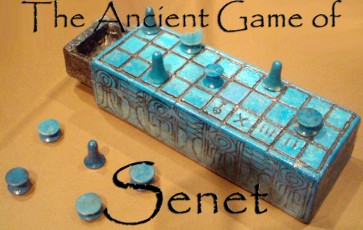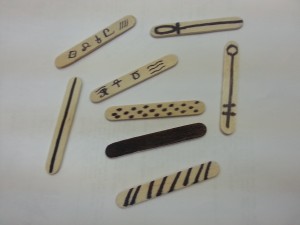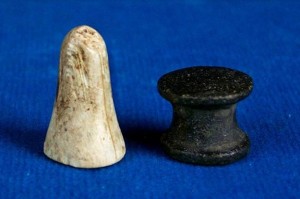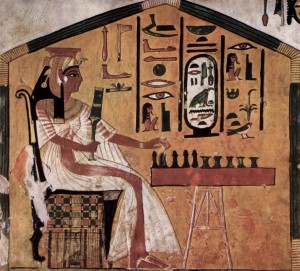The Ancient Game of Senet

Senet is an board game from ancient Egypt. It is not known how far back in history the game originated, but it dates back to at least 3100 BCE, which is predynastic Egypt. The game has been found in tombs and archaeological digs throughout Egypt, in King Tut’s tomb four complete sets were found leading to the belief that it was probably his favourite game. The rules to the game have long been lost, but there have been attempts to reproduce the rules that seem realistic given the information we know about the game.
The game is a relatively simple chase game, the board is a 10X3 board as shown below. The pawns move in an s shape around the board and off, moving left to right on the first row, right to left on the second, and finally left to right again on the final row.
A player cannot land on a square occupied by another of their own pawns, but they can take the square occupied by an opponents pawn. When this happens the opponents pawn gets moved back to where the capturing pawn started from. A pawn on any of the specially marked squares cannot be captured.
Each special square has its own purpose, they are as follows:
The final five squares:
- the first of the last squares (the 26th square) is the House of Happiness. This is a mandatory square and no pawns may be moved off the board without first landing on this square.
- The house of Water comes next, this is a dangerous square to land on, if in the next turn the player cannot roll their pawn off of this square they are sent back to the House of Rebirth
- The next few squares do not have specific recorded names, but a player that lands on them needs to roll exactly enough to get off the board to move from the square.
The centre square (15th square) is the House of Rebirth. This square is where pawns who get banished from the house of water end up.
 The game of Senet does not use dice but rather casting sticks. The image to the right shows some simple casting sticks I made out of craft Popsicle sticks. The one side is marked the opposite side is not. Traditionally Senet is played with four casting sticks. Counting is as follows:
The game of Senet does not use dice but rather casting sticks. The image to the right shows some simple casting sticks I made out of craft Popsicle sticks. The one side is marked the opposite side is not. Traditionally Senet is played with four casting sticks. Counting is as follows:
- One marked sides face up
- Two marked sides face up
- Three marked sides face up
- Four marked sides face up
- Zero marked sides face up
 Each player starts out with seven pawns each, shown on the left are the standard shapes for the pawns, so one player would have seven cones, the other would have seven spools. To set up the board the first fourteen squares (remembering that the squares are counted in an “S” shape) alternate cone and spool starting with cone, which places a spool as the last pawn on the board on square fourteen. Because spool has the advantage of having a man closest to the off the board the cones always go first. The casting sticks are cast to see how many squares they can move, the game begins.
Each player starts out with seven pawns each, shown on the left are the standard shapes for the pawns, so one player would have seven cones, the other would have seven spools. To set up the board the first fourteen squares (remembering that the squares are counted in an “S” shape) alternate cone and spool starting with cone, which places a spool as the last pawn on the board on square fourteen. Because spool has the advantage of having a man closest to the off the board the cones always go first. The casting sticks are cast to see how many squares they can move, the game begins.
The first player to successfully get all of their men off the board wins.

